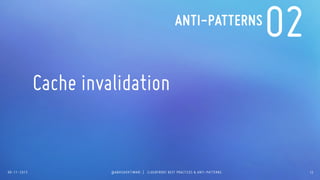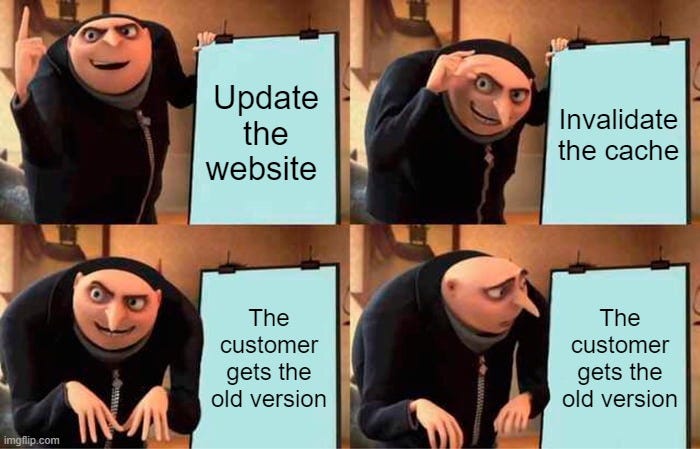Content Invalidation

- Identify high-impact content: Determine which content updates will have a significant effect on traffic or revenue.
- Use specific invalidation rules: Specify the exact URLs or file paths that need to be invalidated. Avoid using wildcards or broad rules.
- Invalidate immediately: Invalidate content as soon as it has been updated to prevent serving outdated versions.
- Batch invalidations: Group multiple invalidation requests together to reduce overhead and improve efficiency.
- Monitor invalidation status: Track the progress of invalidation requests to ensure they are completed successfully.
Content Purging

- Purge regularly: Establish a regular purging schedule based on content lifecycle and usage patterns.
- Use file modification times: Purge files that have not been modified within a specified period.
- Identify stale content: Use analytics or monitoring tools to identify content that is no longer being accessed or is outdated.
- Purge specific files: Target specific files or directories for purging, rather than purging entire sections of content.
- Monitor purging status: Track the progress of purging requests to ensure they are completed successfully.
Best Practices for Both

- Test thoroughly: Test invalidation and purging rules extensively before deploying them in production.
- Use automated tools: Utilize tools such as CDN management platforms or API scripts to automate the invalidation and purging process.
- Monitor CDN performance: Regularly check CDN logs and metrics to ensure that invalidation and purging requests are being processed efficiently.
- Collaborate with content owners: Work closely with content authors and editors to ensure that they understand the implications of invalidating or purging content.
- Educate users: Inform users about the potential impact of invalidations and purges on their experience.
Additional Tips
- Use a CDN with fast invalidation times: Choose a CDN that supports near-instantaneous invalidation for critical content.
- Consider using a warm-up cache: Store recently invalidated content in a warm-up cache to reduce latency when users access the updated version.
- Leverage multiple CDNs: Utilize multiple CDNs with different invalidation and purging capabilities to enhance redundancy and reliability.
- Follow industry standards: Refer to guidelines from organizations such as the CDN Alliance for best practices on content invalidation and purging.## Best Practices For CDN Content Invalidation And Purging
Executive Summary
Content Invalidation and Purging are essential techniques for ensuring that users always see the most up-to-date version of your website content. Invalidating and purging outdated content from your CDN can improve website performance, user experience, and SEO.
Introduction
Website content is often cached by CDNs (content delivery networks) to improve website load times. However, when you make changes to your website content, the old, outdated version of the content may still be cached by the CDN. This can lead to users seeing outdated content, which can be confusing and frustrating.
Content invalidation and purging are two techniques that can be used to ensure that users always see the most up-to-date version of your website content. Content invalidation involves marking a specific URL or set of URLs as invalid, which instructs the CDN to remove the cached content for that URL. Content purging involves removing all cached content from a CDN, regardless of the URL.
FAQs
1. What is the difference between content invalidation and content purging?
Content invalidation involves marking a specific URL or set of URLs as invalid, which instructs the CDN to remove the cached content for that URL. Content purging involves removing all cached content from a CDN, regardless of the URL.
2. When should I use content invalidation?
Content invalidation should be used when you make changes to a specific URL or set of URLs on your website. For example, if you update a blog post or add a new product to your online store, you should invalidate the CDN cache for that URL.
3. When should I use content purging?
Content purging should be used when you make significant changes to your website, such as redesigning your website or migrating to a new hosting provider. Content purging can also be used to remove all cached content from a CDN in the event of a security breach.
Subtopics
CDN Caching
CDN caching stores frequently requested files on servers located closer to end users to reduce latency and improve page load times. This process involves copying static content, such as images, CSS, and JavaScript files, to edge servers distributed across different geographic locations.
- Reduced latency: CDN caching brings content closer to users, decreasing the time it takes for files to load and improving overall website performance.
- Increased scalability: By distributing content across multiple servers, CDNs can handle high traffic volumes without compromising website availability.
- Improved user experience: Faster page load times enhance the user experience and reduce bounce rates, leading to increased engagement and conversions.
CDN Content Invalidation
CDN content invalidation ensures that changes made to the origin server are reflected on the CDN’s edge servers. When content is updated or removed from the origin, the CDN must be notified to invalidate the cached version on its edge servers.
- Real-time content updates: Content invalidation allows users to access the latest version of the content immediately after it has been updated on the origin server.
- Improved accuracy: Invalidating outdated content prevents users from accessing incorrect or irrelevant information, enhancing the credibility and reliability of the website.
- Enhanced security: Content invalidation helps prevent outdated content from being cached and potentially compromised, reducing the risk of security breaches.
CDN Purging
CDN purging involves removing all cached content from a CDN’s edge servers, regardless of the URL. This process is typically used when significant changes are made to the website, such as a redesign or a migration to a new platform.
- Complete content removal: Purging ensures that all cached content is removed, preventing outdated or incorrect information from being served to users.
- Improved website performance: By removing all cached content, purging can help improve website performance and reduce the risk of errors or inconsistencies.
- Enhanced security: Purging helps prevent sensitive or outdated content from being cached, reducing the risk of security vulnerabilities.
CDN Prefetching
CDN prefetching involves identifying and fetching specific resources before a user requests them. This process helps reduce page load times by anticipating user behavior and caching the necessary content in advance.
- Reduced latency: Prefetching brings frequently requested resources closer to users, minimizing the time it takes to load them when a user visits the website.
- Improved user experience: By preloading essential content, prefetching enhances the user experience and increases website engagement.
- Enhanced efficiency: Prefetching reduces the load on the origin server by caching commonly used files, freeing up resources for other tasks.
CDN Monitoring
CDN monitoring involves tracking and analyzing the performance of the CDN to ensure optimal delivery of content. This process includes monitoring metrics such as latency, uptime, and error rates.
- Proactive troubleshooting: CDN monitoring helps identify potential issues before they impact user experience, allowing for proactive troubleshooting and maintenance.
- Performance optimization: By analyzing CDN performance data, website owners can identify areas for improvement and optimize the CDN configuration to enhance content delivery.
- Improved user experience: CDN monitoring ensures the CDN is delivering content reliably and efficiently, contributing to a positive user experience.
Conclusion
Content invalidation and purging are essential techniques for ensuring that users always see the most up-to-date version of your website content. By implementing these techniques, you can improve website performance, user experience, and SEO.
Keyword Tags
- CDN content invalidation
- CDN content purging
- CDN caching
- CDN prefetching
- CDN monitoring
